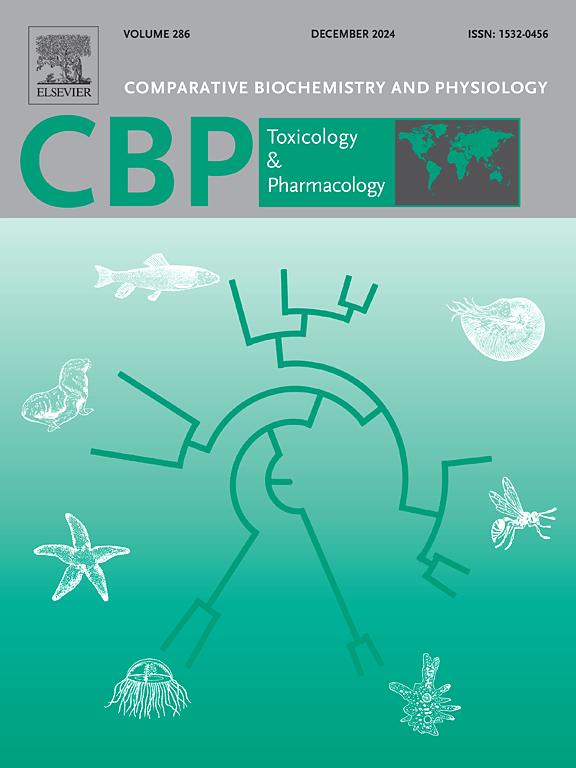恶性脑肿瘤中与小鲍鱼免疫启动和吞噬调节相关的DMBT1基因缺失。
IF 3.9
3区 环境科学与生态学
Q2 BIOCHEMISTRY & MOLECULAR BIOLOGY
Comparative Biochemistry and Physiology C-toxicology & Pharmacology
Pub Date : 2025-01-14
DOI:10.1016/j.cbpc.2025.110126
引用次数: 0
摘要
小鲍鱼(haaliotis diversicolor)是中国南部沿海养殖的一种经济贝类。近年来,该病的频繁发生已导致鲍鱼养殖场大量死亡。恶性脑肿瘤中缺失1 (DMBT1)是富半胱氨酸(SRCR)清道夫受体蛋白家族的一员,在宿主防御中起重要作用。然而,其在H. diversicolor中的作用尚不清楚。为了评估继发性感染后的免疫启动效应并阐明可能的调控机制,本研究克隆了一种来自小鲍鱼(H. diversicolor)的新型DMBT1(命名为HdDMBT1)并对其进行了表征。HdDMBT1的开放阅读框为2331 bp,编码776个氨基酸,分子量为84.73 kDa。HdDMBT1与其他物种的DMBT1含有保守的活性位点,在所有测试组织中都检测到,并且在肝胰腺中表达水平更高。研究了HdDMBT1在两次哈维弧菌攻击后的时间表达谱,以评估小鲍鱼的启动反应。哈维氏菌攻毒后,肝胰腺中HdDMBT1 mRNA的表达量显著升高。与此同时,HdDMBT1在第二次刺激后的表达量显著高于第一次刺激后的表达量(4.23倍)。通过RNA干扰(RNAi)实验研究了HdDMBT1在抗哈维氏梭菌感染中的作用。抑制HdDMBT1降低血细胞吞噬能力(0.48倍)。此外,注射dsHdDMBT1后,哈威氏弧菌感染鲍鱼后,其血淋巴细菌密度和死亡率均升高。这些结果表明,HdDMBT1可能在细菌感染耐受中起重要作用。本文章由计算机程序翻译,如有差异,请以英文原文为准。

Deleted in malignant brain tumors 1 (DMBT1) gene relate to immune priming and phagocytosis modulation in the small abalone Haliotis diversicolor
The small abalone (Haliotis diversicolor) is an economic shellfish cultured in the south coast of China. In recent years, the frequent occurrence of the disease has led to significant mortality in abalone farms. Deleted in malignant brain tumors 1 (DMBT1), a member of the scavenger receptor cysteine-rich (SRCR) protein family, plays an important role in host defense. However, its function in H. diversicolor remains unknown. In order to evaluate the immune priming effect after secondary infection and elucidate possible regulatory mechanism, a novel DMBT1 from the small abalone H. diversicolor (designated as HdDMBT1) was cloned and characterized in this study. The open reading frame of HdDMBT1 was 2331 bp encoding 776 amino acids with a molecular weight of 84.73 kDa. HdDMBT1 contained conserved active sites with DMBT1 from other species, detected in all tested tissues and had higher expression levels in hepatopancreas. The temporal expression profiles of HdDMBT1 after two challenges of Vibrio harveyi were examined to evaluate priming response in the small abalone. The expression level of HdDMBT1 mRNA in hepatopancreas increased significantly after V. harveyi challenge. Meanwhile, the expression level of HdDMBT1 after the second challenge was significantly higher than that after the first challenge (4.23-fold). RNA interference (RNAi) experiments were conducted to examine the role of HdDMBT1 in response to V. harveyi infection. Knocking down HdDMBT1 decreased the hemocytes phagocytosis (0.48-fold). In addition, the bacterial density in hemolymph and the mortality of abalone raised, when infected with V. harveyi after dsHdDMBT1 injection. These results indicated that HdDMBT1 might play an important role in tolerance to bacterial infection.
求助全文
通过发布文献求助,成功后即可免费获取论文全文。
去求助
来源期刊
CiteScore
7.50
自引率
5.10%
发文量
206
审稿时长
30 days
期刊介绍:
Part C: Toxicology and Pharmacology. This journal is concerned with chemical and drug action at different levels of organization, biotransformation of xenobiotics, mechanisms of toxicity, including reactive oxygen species and carcinogenesis, endocrine disruptors, natural products chemistry, and signal transduction with a molecular approach to these fields.

 求助内容:
求助内容: 应助结果提醒方式:
应助结果提醒方式:


